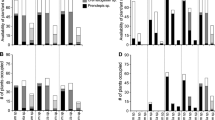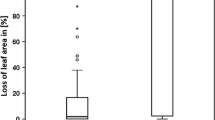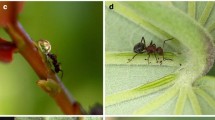Abstract
Myrmecophytic symbioses are widespread in tropical ecosystems and their diversity makes them useful tools for understanding the origin and evolution of mutualisms. Obligate ant–plants, or myrmecophytes, provide a nesting place, and, often, food to a limited number of plant–ant species. In exchange, plant–ants protect their host plants from herbivores, competitors and pathogens, and can provide them with nutrients. Although most studies to date have highlighted a similar global pattern of interactions in these systems, little is known about the temporal structuring and dynamics of most of these associations. In this study we focused on the association between the understory myrmecophyte Hirtella physophora (Chrysobalanaceae) and its obligate ant partner Allomerus decemarticulatus (Myrmicinae). An examination of the life histories and growth rates of both partners demonstrated that this plant species has a much longer lifespan (up to about 350 years) than its associated ant colonies (up to about 21 years). The size of the ant colonies and their reproductive success were strongly limited by the available nesting space provided by the host plants. Moreover, the resident ants positively affected the vegetative growth of their host plant, but had a negative effect on its reproduction by reducing the number of flowers and fruits by more than 50%. Altogether our results are important to understanding the evolutionary dynamics of ant–plant symbioses. The highly specialized interaction between long-lived plants and ants with a shorter lifespan produces an asymmetry in the evolutionary rates of the interaction which, in return, can affect the degree to which the interests of the two partners converge.




Similar content being viewed by others
References
Beattie AJ, Hughes L (2002) Ant–plant interactions. In: Herrera CM, Pellmyr O (eds) Plant–animal interactions: an evolutionary approach. Blackwell, Oxford, pp 211–235
Bronstein JL, Wilson WG, Morris WE (2003) Ecological dynamics of mutualist/antagonist communities. Am Nat 162:24–39
Clark DB, Clark DA (1989) The role of physical damage in the seedling mortality regime of a Neotropical rain forest. Oikos 55:225–230
Clark DB, Clark DA (1991) The impact of physical damage on canopy tree regeneration in tropical rain forest. J Ecol 79:447–457
Dejean A, Solano PJ, Ayrolles J, Corbara B, Orivel J (2005) Arboreal ants build traps to capture prey. Nature 434:973
Djiéto-Lordon C, Dejean A, Ring RA, Nkongmeneck BA, Lauga J, McKey D (2005) Ecology of an improbable association: the pseudomyrmecine plant–ant Tetraponera tessmanni and the myrmecophytic liana Vitex thyrsiflora (Lamiaceae) in Cameroon. Biotropica 37:421–430
Easdale TA, Healey JR, Grau HR, Malizia A (2007) Tree life histories in a montane subtropical forest: species differ independently by shade-tolerance, turnover rate and substrate preference. J Ecol 95:1234–1249
Edwards DP, Yu DW (2008) Tolerating castration by hiding flowers in plain sight. Behav Ecol Sociobiol 63:95–102
Feldhaar H, Fiala B, bin Hashim R, Maschwitz U (2000) Maintaining an ant–plant symbiosis: secondary polygyny in the Macaranga triloba–Crematogaster sp. association. Naturwissenschaften 87:408–411
Feldhaar H, Fiala B, Hashim RB, Maschwitz U (2003) Patterns of the Crematogaster–Macaranga association: the ant partner makes the difference. Insect Soc 50:9–19
Fonseca CR (1993) Nesting space limits colony size of the plant–ant Pseudomyrmex concolor. Oikos 67:473–482
Fonseca CR (1999) Amazonian ant–plant interactions and the nesting space limitation hypothesis. J Trop Ecol 15:807–825
Foster KR, Wenseleers T (2006) A general model for the evolution of mutualisms. J Evol Biol 19:1283–1293
Frederickson ME (2009) Conflict over reproduction in an ant–plant symbiosis: why Allomerus octoarticulatus ants sterilize Cordia nodosa trees. Am Nat 173:675–681
Gartner BL (1989) Breakage and regrowth of Piper species in rain forest understory. Biotropica 21:303–307
Gaume L, Zacharias M, Borges RM (2005) Ant–plant conflicts and a novel case of castration parasitism in a myrmecophyte. Evol Ecol Res 7:435–452
Gourlet-Fleury S, Blanc L, Picard N, Sist P, Dick J, Nasi R, Swaine MD, Forni E (2005) Grouping species for predicting mixed tropical forest dynamics: looking for a strategy. Ann For Sci 62:785–796
Grangier J, Dejean A, Malé PJG, Orivel J (2008) Indirect defense in a highly specific ant–plant mutualism. Naturwissenschaften 96:57–63
Grangier J, Dejean A, Malé PJG, Solano PJ, Orivel J (2009) Mechanisms driving the specificity of a myrmecophyte–ant association. Biol J Linn Soc 97:90–97
Heil M, McKey D (2003) Protective ant–plant interactions as model systems in ecological and evolutionary research. Annu Rev Ecol Evol Syst 34:425–453
Herre EA, Knowlton N, Mueller UG, Rehner SA (1999) The evolution of mutualisms: exploring the paths between conflict and cooperation. Trends Ecol Evol 14:49–53
Izzo TJ, Vasconcelos HL (2002) Cheating the cheater: domatia loss minimizes the effects of ant castration in an Amazonian ant–plant. Oecologia 133:200–205
Leroy C, Jauneau A, Quilichini A, Dejean A, Orivel J (2008) Comparison between the anatomical and morphological structure of leaf blades and foliar domatia in the ant–plant Hirtella physophora (Chrysobalanaceae). Ann Bot 101:501–507
McCormac FG, Hogg AG, Blackwell PG, Buck CE, Higham TFG, Reimer PJ (2004) SHCal04 Southern Hemisphere calibration 0–11.0 cal kyr BP. Radiocarbon 46:1087–1092
Nascimento HEM, Laurance WF, Condit R, Laurance SG, D’Angelo S, Andrade AC (2005) Demographic and life-history correlates for Amazonian trees. J Veg Sci 16:625–634
Nydal R, Lövseth K (1983) Tracing bomb 14C in the atmosphere 1962–1980. J Geophys Res 88:3621–3642
Prance GT (1972) Monograph of the Chrysobalanaceae. Flora Neotropica 9:1–410
Sachs JL, Mueller UG, Wilcox TP, Bull JJ (2004) The evolution of cooperation. Q Rev Biol 79:135–160
Solano PJ, Dejean A (2004) Ant-fed plants: comparison between three geophytic myrmecophytes. Biol J Linn Soc 83:433–439
Solano PJ, Durou S, Corbara B, Quilichini A, Cerdan P, Belin Depoux M, Delabie JHC, Dejean A (2003) Myrmecophytes of the understory of French Guianian rainforests: their distribution and their associated ants. Sociobiology 41:605–614
Stanton ML (2003) Interacting guilds: moving beyond the pairwise perspective on mutualisms. Am Nat 162:10–23
Stanton ML, Palmer TM, Young TP, Evans A, Turner ML (1999) Sterilization and canopy modification of a swollen thorn acacia tree by a plant–ant. Nature 401:578–581
Stuiver M, Becker B (1986) High-precision decadal calibration of the radiocarbon time scale, AD 1950–2500 BC. Radiocarbon 28:863–910
Szilágyi A, Scheuring I, Edwards DP, Orivel J, Yu DW (2009) The evolution of intermediate castration virulence and ant coexistence in a spatially structured environment. Ecol Lett 12:1–11
Vieira S, Trumbore S, Camargo PB, Selhorst D, Chambers JQ, Higuchi N, Martinelli LA (2005) Slow growth rates of Amazonian trees: consequences for carbon cycling. Proc Natl Acad Sci USA 102:18502–18507
Young TP, Stubblefield CH, Isbell LA (1997) Ants on swollen-thorn acacias: species coexistence in a simple system. Oecologia 109:98–107
Yu DW (2001) Parasites of mutualisms. Biol J Linn Soc 72:529–546
Yu DW, Pierce NE (1998) A castration parasite of an ant–plant mutualism. Proc R Soc Lond 265:375–382
Acknowledgments
We are grateful to T. Goslar from the Poznan Radiocarbon Laboratory, Poland and M. Paterne from the LSCE CNRS-CEA, France, for their help in the determination of the 14C age, to C. Trontin for her valuable assistance in the lab and to Andrea Dejean for proofreading the manuscript. We would like to thank V. Rico-Gray and two anonymous reviewers for their valuable comments on the manuscript. We would also like to thank the Laboratoire Environnement de Petit Saut for furnishing logistical assistance. Financial support for this study was provided by the Programme Amazonie II (project 2ID) of the French Centre National de la Recherche Scientifique (CNRS), by the Programme Convergence 2007–2013 Région Guyane (project DEGA) from the European Community, by a research program of the French Agence Nationale de la Recherche (research agreement no. ANR-06-JCJC-0109-01), and by the ESF-EUROCORES/TECT/BIOCONTRACT program. The experiments comply with the current laws of France.
Author information
Authors and Affiliations
Corresponding author
Additional information
Communicated by Joshua Tewksbury.
Rights and permissions
About this article
Cite this article
Orivel, J., Lambs, L., Malé, PJ.G. et al. Dynamics of the association between a long-lived understory myrmecophyte and its specific associated ants. Oecologia 165, 369–376 (2011). https://doi.org/10.1007/s00442-010-1739-5
Received:
Accepted:
Published:
Issue Date:
DOI: https://doi.org/10.1007/s00442-010-1739-5




